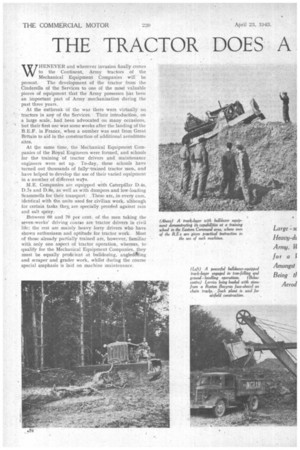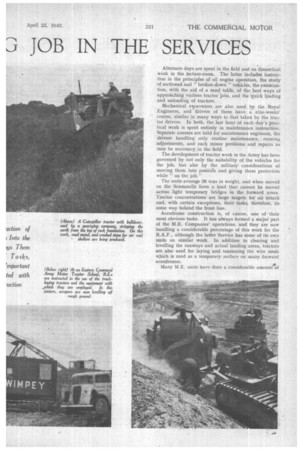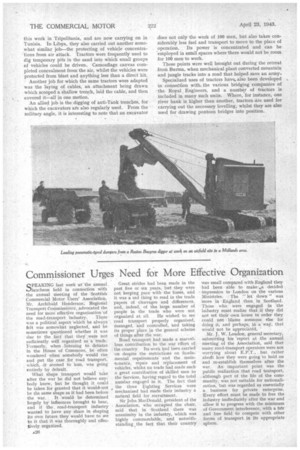THE TRACTOR DOES A JOB IN THE SERVICES
Page 26

Page 27

Page 28

If you've noticed an error in this article please click here to report it so we can fix it.
WHENEVER and wherever invasion finally comes to the Continent, Army tractors of the Mechanical Equipment Companies will be
present. The development of the tractor from the Cinderella of the Services to one of the most valuable pieces of equipment that the Army possesses has been an important part of Army mechanization during the past three years.
At the outbreak of the war there were virtually no tractors in any of the Services. Their introduction, on a large scale, had been advocated on many occasions,
1 but their first use was some weeks after the landing of the B.E.F. in France, when a number was sent from Great Britain to aid in the construction of additional aerodrome sites.
At the same time, the Mechanical Equipment Companies of the Royal Engineers were formed, and schools for the training of tractor drivers and, maintenance engineers were set up. • To-day, these schools have turned out thousands of fullytrained tractor men, and have helped to develop the use of their varied equipment
in a number of different ways. , M.E. Companies are equipped with Caterpillar D.4s, D.7s and D.8s, as well as with dumpers and low-loading Scanunells for their transport. _These are, in every case, identical with the units used for civilian work, although for certain tasks they, are specially proofed against rain and salt spray.
Between 60 and 70 per cent. of the men taking the seven-weeks' driving course are tractor drivers in civil life; the rest are mainly heavy lorry drivers who have shown enthusiasm and aptitude for tractor work. Most of those already partially trained are, however, familiar with only one aspect of tractor operation, whereas, to qualify for the Mechanical Equipment Companies, they must be equally proficient at bulldozing, angled&ing and scraper and grader work, whilst during the course special emphasis is laid on machine maintenance.
• Alternate days are spent in the field and on theoretical work in the lecture-room. The latter includes instruction in the principles of oil engine operation, the study of sectioned and " broken-down " vehicles, the examination, with the aid of a sand table, of the best ways of approaching various tractor jobs, and the quick loading • and unloading of tractors.
Mechanical excavators are also used by the Royal Engineers, and 'drivers of these have a nine-weeks'
' course, similar in many ways to that taken by the tractor drivers. In both, the last hour of each day's practical work is spent entirely in. maintenance instruction. Separate courses are held for maintenance engineers, the drivers handling only routine maintenance, running adjustments, and such minor problems and repairs as may be necessary in the field.
The development of tractor work in the Army has been governed by not only the suitability of the vehicles for the job, but. also by the military considerations of moving them into positic7n and giving them protection while "on the job."
The units average 20 tons in weight, and when moved on the Scammells form a load that cannot be moved across light temporary bridges in the forward areas. Tractor concentrations are large targets for air attack and, with certain exceptions, their tasks, therefore, lie some way behind the front line.
Aerodrome construction is, of course, one of their most obvious tasks. It has always formed a major part of the M.E. Companies' operations, and they are now handling a considerable percentage of this work for the R.A.F., although the latter Service has some of its own units on similar work. In addition to clearing and levelling the runways and actual landing areas, tractors are also used for laying and tensioning the wire mesh which is used as a temporary surface on many forward aerodromes.
Many M.E. units have done a considerable amount of
this work in Tripolitania, and are now carrying on in Tunisia. In Libya, they also carried out another somewhat similar job—the protecting of vehicle concentrations from air attack. Tractors were frequently used to dig temporary pits in the sand into which small groups of vehicles could be driven. Camouflage canvas completed concealment from the air, whilst the vehicles were protected from blast and anything less than a direct hit.
Another job for which the same tractors were adapted was the laying of cables, an attachment being drawn which scooped a shallow trench, laid the cable, and then covered it—all in one motion.
An allied job is the digging of anti-Tank trenches, for which the excavators are also regularly used. From the military angle, it is interesting to note that an excavator •
.does not only the work of 100 men, but also takes considerably less fuel and transport to move to the place of ‘operation. Its power is concentrated and can be employed in small spaces where there would not be room for 100 men to work.
These points were well brought out during the retreat from Burma, when mechanical plant converted mountain and jungle tracks into a road that helped save an army, Specialized uses of tractors have, also been developed in connection with. the various bridging companies of • the Royal Engineers, and a number of tractors is included in many such units. Where, for instance, one river bank is higher than another, tractors tare used for carrying out the necessary levelling, whilst they are also used for drawing pontoon bridges into position.




















































